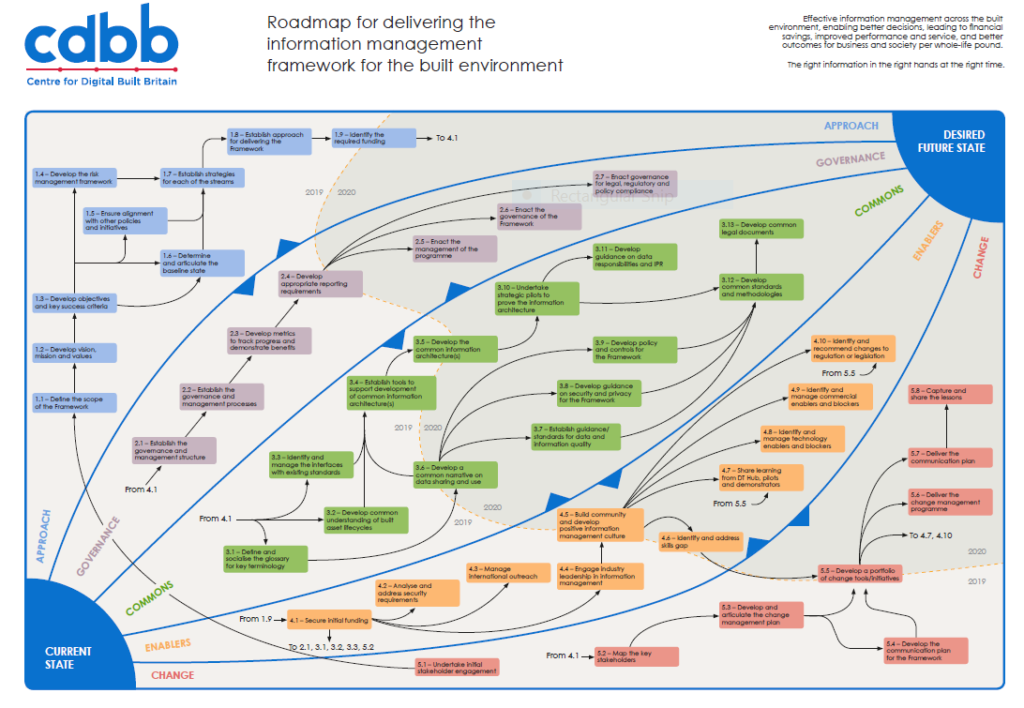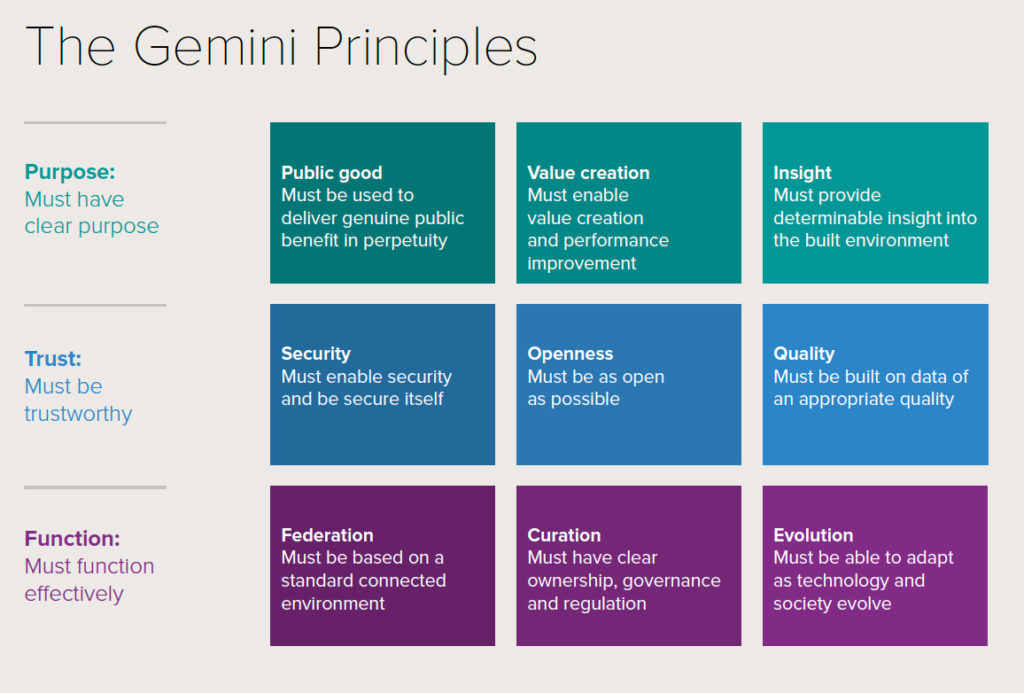The Future is a Digital Twin – just like now (but better and with a twin) – Sarah Rock, Gowling WLG.
As the design and construction world have embraced BIM and its use becomes ever more common, the reverse could be said about the asset management world. Much of the data held in models becomes redundant at the point of handover. Valuable information is left untouched as the built asset begins and continues its life. Digital twins aim to use this valuable data and enhance everyday lives, drive revenue and improve the environment.
A digital twin is a realistic digital representation of something physical such as a building or a railway network, with a link between the two. A twin can be made to replicate a new asset or be modelled from an existing physical asset. Connecting a physical asset with its digital twin helps to make the asset smart. The digital twin can be used to test new ideas or model scenarios without interrupting the actual physical asset and its users. Successful results can then be implemented to help assets run more efficiently, saving time, money and disruption.
CDBB’s National Digital Twin Programme
The Centre for Digital Built Britain (CDBB) has been tasked with making the digital twin future a reality. The CDBB is a partnership between the Department of Business, Energy & Industrial Strategy and the University of Cambridge to deliver a smart digital economy for infrastructure and construction for the future and to transform the UK construction industry’s approach to the way we plan, build, maintain and use our social and economic infrastructure. The CDBB brings together industry, academia, and policy makers in order to consider the wider effects of the digital agenda on society and the economy.
Launched by HM Treasury in July 2018, CDBB’s National Digital Twin (NDT) Programme and Digital Framework Task Group were set up to deliver key recommendations of the National Infrastructure Commission (NIC) 2017 “Data for the Public Good Report” notably:
- to steer the successful development and adoption of the information management framework for the built environment, and
- to create an ecosystem of connected digital twins – a national digital twin– which opens the opportunity to release value for society, the economy, business and the environment.
A NDT is not intended to be one entire twin of the whole national infrastructure, rather it is intended to consist of “federations” of digital twins joined together via securely shared data, enabling infrastructure professionals to make better decisions at project, asset, network or system level. One working example could be the scenario whereby an office block in the City of London has to be suddenly and unexpectedly evacuated. The digital twin of the office block could alert the digital twins of local transport systems so that more buses are directed to the area or more gates open at the local underground station to assist with the swift and safe evacuation of the office block staff, The NDT could also go on to help answer questions around housing, transport routes, energy and net zero carbon.
The NDT programme has been working with future users and early adopters of digital twins to develop an information management framework to connect digital twins to deliver benefit to all. The creation of the framework forms an integral part of HM Government’s modern Industrial Strategy and Construction Sector Deal.
Initial work of the NDT Programme
Common definitions and approaches to information management were at the core of the initial activity of the NDT Programme and in 2019 it launched a Roadmap detailing a prioritised plan for five core streams responsible for the delivery of the information management framework.

In 2018 the NDT Programme launched the Gemini Principles, a paper setting out the proposed principles to guide the national digital twin and the information management framework that will enable it. The Gemini Principles Report is intended to assist with alignment on the approach to information management across the built environment by establishing agreed definitions and principles from the outset which will make it easier to share data in the future.

The Gemini Principles are deliberately simple and enshrine the intention that all digital twins have clear purpose, must be trustworthy and must function effectively. The NDT Programme is focussed highly on the public good and these principles help to set this tone.
Does this signal the end of BIM?
The work that the BIM community and the adoption of it by the design and construction industries has been a stepping stone which has allowed the next development (digital twins) to come about. Without BIM as one of its core foundations a digital twin would not exist. The digital twin is merely the next step and ensures that the great work achieved by those who have believed in and driven the BIM revolution at design and construction level is not lost at the point of an asset coming into use.
The paragraph above is not complacent, the writer acknowledges there is still some way to go before BIM is business as usual. But just focussing on this one element of the digitisation of the construction and infrastructure world is no longer enough. Digital twins and the NDT Programme require all elements of the digital world to come together and collaborate.
Recent Progress
Following the publication of the Gemini Principles and the Roadmap the NDT Programme held its first National Digital Twin Day in September 2019. Hosted by the Institution of Civil Engineers at its London HQ, the day featured contributions by digital pioneers from government and industry delivering expert guidance and practical insights on digital twins. Events during the day discussed the latest developments, challenges and opportunities this emerging sector brings, highlighting how digital twin thinking can drive more value from data, optimise infrastructure performance and deliver better outcomes for society.
Two years after the NIC’s ‘Data for the Public Good Report’ set out a vision for the NDT to improve the way we plan, build, use and manage our infrastructure, the vision is gaining momentum and support and having been cited by the NIC as having the potential to unlock an additional £7Bn per year of benefits across the UK infrastructure sector the NDT Programme is starting to make people sit up and recognise the financial and social benefits this exciting development can bring.
The CDBB’s Digital Twin Hub ‘DT Hub’ was announced at the National Digital Twin Day. The Hub allows members to share experiences and learn from others on the same path in a safe and secure environment. The DT Hub is steered by a group of experts from the worlds of academia, government and industry. A work in progress, the DT Hub will launch at the end of March as will soon be sharing information about Digital Twin projects currently running across the UK.
Legal Implications
The NDT Programme has quite wisely recognised that there may be one or two legal implications which crop up in the adoption of the above! The Roadmap stream leaders are currently working on identifying, assessing and attempting to provide solutions to the obvious legal risks and liabilities of sharing data, connecting individual twins, GDPR etc.
As a construction lawyer, the writer acknowledges there have been issues which have arisen in the adoption of BIM and breaking down trust issues to encourage collaboration. However, these can and often have been overcome through clear commercial discussions reflected in thorough and knowledgeable legal drafting in this area (a legal twin as it were). There is work to be done in this area but the NDT Programme is utilising industry and academic experts to provide some framework around this and more will follow on this particular point.
Is the industry as a whole ready for this next step?
Efforts have been made in taking up digital techniques across the industry but the tipping point could ultimately come due to shortage of skills in this new and fast paced arena.
The construction industry is facing a skills shortage as tech and digital skills are increasingly important to the industry. Upskilling current workers to absorb the digital led roles can help in solving this. For the long term however, the industry needs to engage with the younger generation and attract talent which is being lured by the tech companies into our industry.
The power in the digital way of working won’t just come from one digital twin or one change but by collaboration and by all organisations being able to analyse data across several sources to reach actionable conclusions for the betterment of the built environment and our society as a whole.
Sarah Rock is a Principal Associate in the Construction and Engineering team at international law firm Gowling WLG. Sarah recently joined the CDBB’s Digital Framework Task Group as the sole legal representative to assist with the NDT Programme.
If you would like to read more articles like this then please click here.
The post The future is a Digital Twin appeared first on UK Construction Online.

